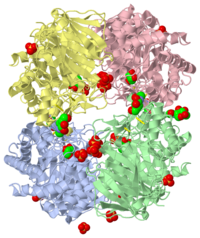Structure of acid-beta-glucosidase with pharmacological chaperone provides insight into Gaucher disease
(see also Treatment of Gaucher disease)
Publication Abstract from PubMed
Gaucher disease results from mutations in the lysosomal enzyme acid beta-glucosidase (GCase). Although enzyme replacement therapy has improved the health of some affected individuals, such as those with the prevalent N370S mutation, oral treatment with pharmacological chaperones may be therapeutic in a wider range of tissue compartments by restoring sufficient activity of endogenous mutant GCase. Here we demonstrate that isofagomine (IFG, 1) binds to the GCase active site, and both increases GCase activity in cell lysates and restores lysosomal trafficking in cells containing N370S mutant GCase. We also compare the crystal structures of IFG-bound GCase at low pH with those of glycerol-bound GCase at low pH and apo-GCase at neutral pH. Our data indicate that IFG induces active GCase, which is secured by interactions with Asn370. The design of small molecules that stabilize substrate-bound conformations of mutant proteins may be a general therapeutic strategy for diseases caused by protein misfolding and mistrafficking.
Structure of acid beta-glucosidase with pharmacological chaperone provides insight into Gaucher disease., Lieberman RL, Wustman BA, Huertas P, Powe AC Jr, Pine CW, Khanna R, Schlossmacher MG, Ringe D, Petsko GA, Nat Chem Biol. 2007 Feb;3(2):101-7. Epub 2006 Dec 24. PMID:17187079
From MEDLINE®/PubMed®, a database of the U.S. National Library of Medicine.
of the native human acid β-glucosidase, expressed in cultured plant cells (pGlcCerase, 2v3f) on those of N-butyl-deoxynojirimycin/pGlcCerase (2v3d), N-nonyl-deoxynojirimycin/pGlcCerase (2v3e), and isofagomine/deglycosylated Cerezyme (IFG/DG-Cerezyme, 2nsx) reveals significant structural identity, neither of these ligands causes structural changes upon binding to the enzyme. The imino sugar of N-butyl-deoxynojirimycin forms 7 hydrogen bonds and also makes several hydrophobic interactions with side chains of active site residues (2v3d). The crystal structure of pGlcCerase in complex with N-nonyl-deoxynojirimycin (2v3e) is very similar to that of NB-DNJ/pGlcCerase. The exception is that longer chain of NN-DNJ interacts with 2 additional residues Leu241 (labeled lime) and Leu314 of symmetrically related monomer (not shown). Comparison of the structures of NB-DNJ/pGlcCerase (2v3d) and NN-DNJ/pGlcCerase (2v3e) with that of (2nsx) shows that the pyranose-like ring forms a same number of hydrogen bonds with the enzyme in all three cases (2v3d, 2v3e, and 2nsx).
Disease
Known disease associated with this structure: Gaucher disease, perinatal lethal OMIM:[606463], Gaucher disease, type I OMIM:[606463], Gaucher disease, type II OMIM:[606463], Gaucher disease, type III OMIM:[606463], Gaucher disease, type IIIC OMIM:[606463]
About this Structure
2NSX is a 4 chains structure of sequences from Homo sapiens. Full crystallographic information is available from OCA.

